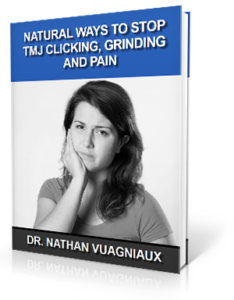 When you hear the phrase “TMJ”, you might think about painful popping, clicking or locking of the jaw. TMJ is an abbreviation for temporomandibular joint, or the two jaw joints located on both sides of the face just in front of the ears. The term TMJ is commonly used to describe a group of conditions that cause both dysfunction and pain in the jaw joint itself and in the muscles that control its movement.
When you hear the phrase “TMJ”, you might think about painful popping, clicking or locking of the jaw. TMJ is an abbreviation for temporomandibular joint, or the two jaw joints located on both sides of the face just in front of the ears. The term TMJ is commonly used to describe a group of conditions that cause both dysfunction and pain in the jaw joint itself and in the muscles that control its movement.
Your temporomandibular joints are arguably among the most complex in your entire body. The TMJ is formed from the lower part of the jaw, the mandible, coming together with the temporal bone of the skull on either side of the head. It differs from the body’s other joints because it combines two specific movements – hinging open and shut and gliding forward and back. To ensure that the jaw operates smoothly, a soft disc cushions the joint and absorbs the stresses the joint going through when chewing, yawning, talking and otherwise moving.
Signs and Symptoms of a TMJ Problem
One of the biggest myths surrounding jaw pain and TMJ dysfunction is that if your jaw doesn’t pop or click, then it must be fine. The truth is that there are many other common signs and symptoms of TMJD, and your jaw need not click or otherwise make noise for there to be an underlying issue present. These symptoms include:
- Earaches
- Neck pain
- Tenderness around the jaw
- Pain while chewing
- Aching facial pain
- Headaches
- Locking of the jaw, making it difficult to open and close your mouth
- Clicking, popping or grating of the jaw joint, which may or may not be painful
What causes temporomandibular joint pain can vary from person to person. The joint itself can become injured or damaged by a blow to the face or another impact. The cartilage in the joint can become degenerate due to arthritis, and the disc that aids in smooth jaw movement can wear out or be aligned improperly. Jaw issues may also arise from the muscles that control chewing, or from the neck.
To learn more about the connection between head and neck injuries and TMJ download our complimentary e-book by clicking the image below.
TMJ Pain and the Health of Your Neck
It might not seem immediately obvious that your neck and jaw pain could be related, but evidence points to a connection. Specifically, the upper cervical spine (which consists of the occipital bone of your skull and the upper two vertebrae in the neck – the atlas and axis) can have a large impact on jaw function. Misalignments of the upper neck can cause abnormal movement, muscle tension, and tender points that can influence range of motion and function of the jaw. In one dental study, patients were examined for TMJ disorder first and then had their necks assessed. 88% of the patients who had symptoms of TMJD also had neck pain and 100% of patients who reported clicking in the TMJ without any jaw pain reported neck pain.
Anatomically speaking, the atlas vertebra, the TMJ, and the inner ear are all located within a very small distance from one another. This is important because the atlas vertebra serves a unique function in your spine. It holds the weight of your head on top of it and is also responsible for the majority of the head’s range of movement. Because of its capacity to move around so freely, it can also be vulnerable to misaligning as a result of an injury or wear and tear. Not surprisingly, when the atlas misaligns, it can cause both neck pain and jaw problems.
Upper Cervical Chiropractic Care – A Natural Solution for TMJD
The first course of treatment for TMJD usually comes in the form of a recommendation for an oral appliance (bite guard) by a dentist. Pain medications and dietary changes that eliminate tough, chewy foods are also common and can offer a temporary solution to coping with pain. Because neck and jaw pain are so closely related, many TMJD sufferers are finding lasting, natural relief with a specific type of chiropractic care.
Upper cervical chiropractic care is different in that it focuses on correcting misalignments of the upper neck that might be negatively influencing how the jaw is able to work. An upper cervical misalignment, also called subluxation, can also be the root cause of a lot of the TMJ-related symptoms discussed above, including headaches, ear pain, and neck pain. When an atlas subluxation is present, correcting it and allowing time for the necessary healing to occur is an important step in the search for long-term relief.
The reason why we are able to accomplish such positive results is that each of our patients receives care that is tailored to their needs. The adjustments they receive are customized to match the exact misalignment present, down to fractions of degrees and millimeters. Because of how precise we are, adjustments can hold in place so that our patients receive the maximum benefit from the correction. Being precise also eliminates the need to force adjustments – many people are pleasantly surprised to experience the gentle, effective approach that we use. If you’re ready to explore whether your neck and jaw problems are connected, schedule a no-obligation consultation to discuss your options.
References:
https://www.nidcr.nih.gov/oralhealth/Topics/TMJ/TMJDisorders.htm
To schedule a complimentary consultation call 618-307-9494 or just click the button below.

if you are outside of the local area you can find an Upper Cervical Doctor near you at www.uppercervicalawareness.com.

